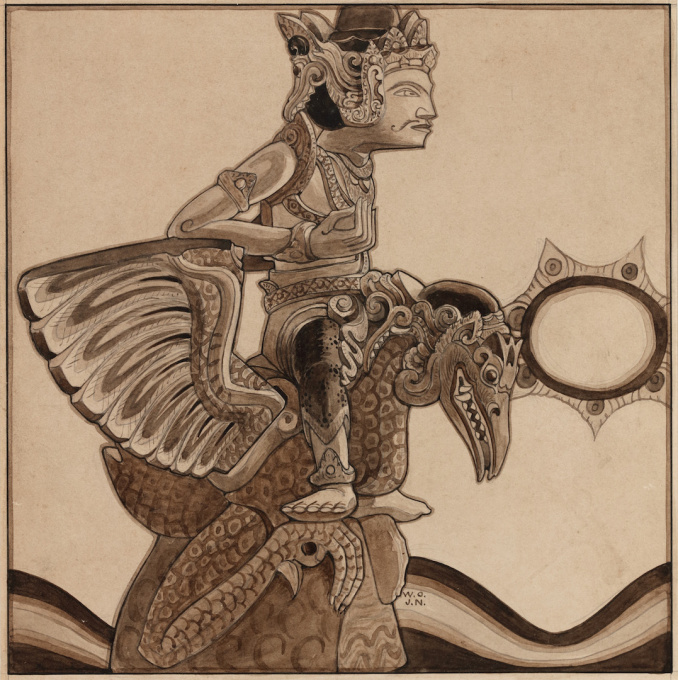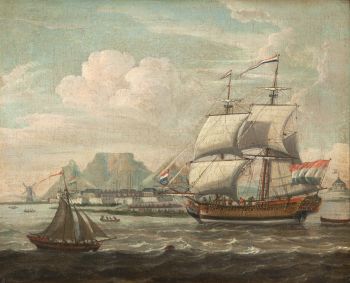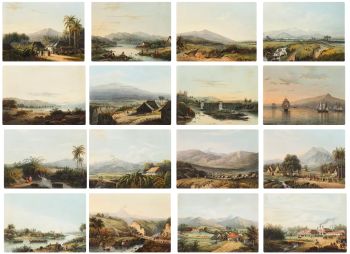Ícone da Rússia Central: Os Três Hierarcas 1900
Willem Otto Wijnand Nieuwenkamp
Preço em pedido
Zebregs & Röell - Fine Art - Antiques
- Sobre arteAn important collection of drawings by W.O.J. Nieuwenkamp (1874-1950)
From the estate of family of the artist
WILLEM OTTO WIJNAND NIEUWENKAMP (1874-1950)
Nieuwenkamp was born on July 27th 1874 in Amsterdam. His father owned sailing ships sailing to Indonesia and hearing the stories of the returning captains evoked in the young Nieuwenkamp an obsession for distant lands and adventure. After a failed attempt by his father to have his son make a career in his business, Nieuwenkamp attended the Academy for Decorative Art in Amsterdam. However, he left within one year to go his own way.
He was an autodidact and a great experimenter with new techniques, particularly in the art of etching. Nieuwenkamp was a very focused man with the discipline of a scientist tempered by the sensitivity of an artist, a lust for adventure, a natural appreciation for ethnic arts and an enormous ambition to tread new paths.
In 1898 he visited Indonesia for the first time and on his second visit in 1903-1904 he went on to Bali and became the first foreign artist to love Bali and the Balinese with a passion. Having secured agreements with several museums in the Netherlands to obtain Balinese art and objects for their collections, Nieuwenkamp immediately started to purchase and order a wide range of ethnographic art and objects from local artists and craftsmen.
Through his drawings and books, he gave an excellent impression of Balinese art and culture at that time. Since 1854 Northern Bali was under Dutch rule but Southern Bali in 1904, when Nieuwenkamp visited it, was still independent. Nieuwenkamp would be one of the last Westerners to experience a glorious medieval society in its final days. During his second visit to Bali in 1906 the Dutch decided to end the independence of South Bali and Nieuwenkamp was invited by the Governor-General van Heutz to accompany the Dutch invasion force. By contemporary European standards, the Balinese were barbarous and primitive, particularly with widows throwing themselves in the flames of the funeral pyre of their deceased husbands. But Nieuwenkamp was a singular man who saw in their society the beauty and soul that had been lost in his own.
On September 20th, 1906, Denpasar, the capital of South Bali fell to the Dutch military forces. Official military briefings praised the victory which was reported with nationalistic pride on the front pages of all Dutch newspapers. As Nieuwenkamp had witnessed, the truth was far from glorious. As if in trance the Balinese, men women and children, dressed in their finest silks and jewellery and armed with ancient bejewelled krises, the Raja himself mounted atop a golden palanquin, rushed forward, the men killing their wives and children and the Dutch machinegun fire doing the rest. The once-powerful and magnificent court of Denpasar was left in ashes and as many as two thousand Balinese dead. The Dutch suffered four deads.
Nieuwenkamp made drawings and saved as many beautiful architectural elements and artefacts from the rubbles as he could, most of it now in the collection of the Ethnological Museum in Leiden. - Sobre artistaWILLEM OTTO WIJNAND NIEUWENKAMP Nieuwenkamp nasceu em 27 de julho de 1874 em Amsterdã. Seu pai era dono de veleiros que navegavam para a Indonésia e ouvir as histórias dos capitães que voltavam evocou no jovem Nieuwenkamp uma obsessão por terras distantes e aventura. Depois de uma tentativa fracassada de seu pai de fazer seu filho seguir carreira em seus negócios, Nieuwenkamp frequentou a Academia de Artes Decorativas em Amsterdã. No entanto, ele partiu em um ano para seguir seu próprio caminho. Ele era um autodidata e um grande experimentador de novas técnicas, particularmente na arte da gravura. Nieuwenkamp foi um homem muito focado, com a disciplina de um cientista temperada pela sensibilidade de um artista, uma ânsia de aventura, um gosto natural pelas artes étnicas e uma enorme ambição de trilhar novos caminhos. Em 1898, ele visitou a Indonésia pela primeira vez e em sua segunda visita em 1903-1904 ele foi para Bali e se tornou o primeiro artista estrangeiro a amar Bali e os balineses com paixão. Tendo firmado acordos com vários museus na Holanda para obter arte balinesa e objetos para suas coleções, Nieuwenkamp imediatamente começou a comprar e encomendar uma ampla gama de arte etnográfica e objetos de artistas e artesãos locais. Por meio de seus desenhos e livros, ele deu uma excelente impressão da arte e da cultura balinesa da época. Desde 1854, o norte de Bali estava sob domínio holandês, mas o sul de Bali em 1904, quando Nieuwenkamp a visitou, ainda era independente. Nieuwenkamp seria um dos últimos ocidentais a experimentar uma gloriosa sociedade medieval em seus dias finais. Durante sua segunda visita a Bali em 1906, os holandeses decidiram acabar com a independência do sul de Bali e Nieuwenkamp foi convidado pelo governador-geral van Heutz para acompanhar a força de invasão holandesa. Pelos padrões europeus contemporâneos, os balineses eram bárbaros e primitivos, especialmente com as viúvas se jogando nas chamas da pira funerária de seus maridos falecidos. Mas Nieuwenkamp foi um homem singular que viu em sua sociedade a beleza e a alma que se perderam na sua. Em 20 de setembro de 1906, Denpasar, a capital do sul de Bali, caiu nas mãos das forças militares holandesas. Briefings militares oficiais elogiaram a vitória, que foi relatada com orgulho nacionalista nas primeiras páginas de todos os jornais holandeses. Como Nieuwenkamp testemunhou, a verdade estava longe de ser gloriosa. Como se estivessem em transe os balineses, homens, mulheres e crianças, vestidos com suas melhores sedas e joias e armados com antigas krises adornadas com joias, o próprio Raja montou em cima de um palanquim, correu para a frente, os homens matando suas esposas e filhos e a metralhadora holandesa fazendo o resto. A outrora poderosa e magnífica corte de Denpasar foi deixada em cinzas e cerca de dois mil balineses mortos. Os holandeses sofreram quatro mortes. Nieuwenkamp fez desenhos e salvou tantos belos elementos arquitetônicos e artefatos dos escombros quanto pôde, a maioria deles agora na coleção do Museu Etnológico de Leiden.
Você está interessado em comprar esta obra de arte?
Related artworks
Artista Desconhecido
A Surinam-themed Amsterdam long-case clock1746 - 1756
Preço em pedidoZebregs & Röell - Fine Art - Antiques
 Com curadoria de
Com curadoria deGallerease Magazine
 Com curadoria de
Com curadoria deDanny Bree
Artista Desconhecido
The bell of the VOC fortress in Jaffna, Sri Lanka1747
Preço em pedidoZebregs & Röell - Fine Art - Antiques
 Com curadoria de
Com curadoria deDanny Bree
Dutch School
Chegada de um índio oriental holandês na Baía da Mesa18th century
Preço em pedidoZebregs & Röell - Fine Art - Antiques
Abraham Salm
Twenty-four chromolithographs of Java after A. Salm”1801 - 1876
Preço em pedidoZebregs & Röell - Fine Art - Antiques
1 - 4 / 12


























